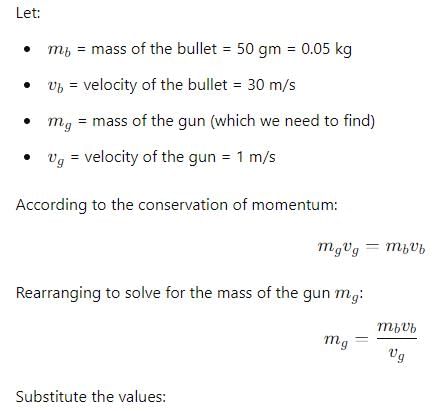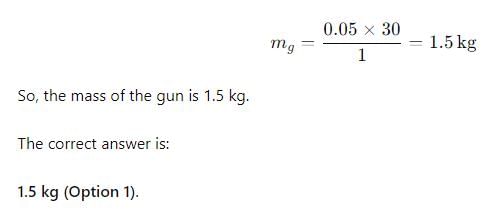NEET Exam > NEET Questions > A gun fires a bullet of mass 50 gm with a vel...
Start Learning for Free
A gun fires a bullet of mass 50 gm with a velocity of 30 ms-1. Because of this the gun is pushed back with a velocity of 1 ms-1. Mass of the gun is
- a)1.5Kg
- b)30Kg
- c)15Kg
- d)20Kg
Correct answer is option 'A'. Can you explain this answer?
Verified Answer
A gun fires a bullet of mass 50 gm with a velocity of 30 ms-1. Because...
The situation described is an example of the conservation of momentum. According to the law of conservation of momentum, the total momentum before firing should be equal to the total momentum after firing, assuming no external forces act on the system.
Let:


Most Upvoted Answer
A gun fires a bullet of mass 50 gm with a velocity of 30 ms-1. Because...
Solution:
Given: mass of bullet (m) = 50 gm = 0.05 kg, velocity of bullet (u) = 30 ms-1, velocity of gun (v) = 1 ms-1.
Let the mass of the gun be 'M'. According to the principle of conservation of momentum:
Initial momentum = Final momentum
The initial momentum is zero since the gun and bullet were at rest initially. The final momentum can be calculated as follows:
Final momentum = (mass of bullet × velocity of bullet) + (mass of gun × velocity of gun)
Final momentum = (0.05 kg × 30 ms-1) + (M × 1 ms-1)
Final momentum = 1.5 kg ms-1 + M ms-1
Therefore, according to the principle of conservation of momentum:
0 = 1.5 kg ms-1 + M ms-1 - M × 1 ms-1
0 = 1.5 kg ms-1
M = 1.5 kg
Therefore, the mass of the gun is 1.5 Kg. Hence, the correct option is (a).
Given: mass of bullet (m) = 50 gm = 0.05 kg, velocity of bullet (u) = 30 ms-1, velocity of gun (v) = 1 ms-1.
Let the mass of the gun be 'M'. According to the principle of conservation of momentum:
Initial momentum = Final momentum
The initial momentum is zero since the gun and bullet were at rest initially. The final momentum can be calculated as follows:
Final momentum = (mass of bullet × velocity of bullet) + (mass of gun × velocity of gun)
Final momentum = (0.05 kg × 30 ms-1) + (M × 1 ms-1)
Final momentum = 1.5 kg ms-1 + M ms-1
Therefore, according to the principle of conservation of momentum:
0 = 1.5 kg ms-1 + M ms-1 - M × 1 ms-1
0 = 1.5 kg ms-1
M = 1.5 kg
Therefore, the mass of the gun is 1.5 Kg. Hence, the correct option is (a).
Free Test
FREE
| Start Free Test |
Community Answer
A gun fires a bullet of mass 50 gm with a velocity of 30 ms-1. Because...
The momentum of the gun (means gun+bullet) remains the same after firing the bullet coz the blast of gun powder is internal therefore the initial and final momentum remain same . Since the initial momentum is zero thus,
MV +mv = o [M and V= mass and velocity of gun
and m and v = mass and velocity of bullet]
M × 1 = 50 × 30
M = 1.5 kg [ the answer comes in negative but we
neglect the minus sign coz mass can't be
in negative]
NOTE - But while talking of velocity in such case we will use the same formula and the answer would be negative depicting velocity is in opposite direction
MV +mv = o [M and V= mass and velocity of gun
and m and v = mass and velocity of bullet]
M × 1 = 50 × 30
M = 1.5 kg [ the answer comes in negative but we
neglect the minus sign coz mass can't be
in negative]
NOTE - But while talking of velocity in such case we will use the same formula and the answer would be negative depicting velocity is in opposite direction

|
Explore Courses for NEET exam
|

|
Question Description
A gun fires a bullet of mass 50 gm with a velocity of 30 ms-1. Because of this the gun is pushed back with a velocity of 1 ms-1. Mass of the gun isa)1.5Kgb)30Kgc)15Kgd)20KgCorrect answer is option 'A'. Can you explain this answer? for NEET 2025 is part of NEET preparation. The Question and answers have been prepared according to the NEET exam syllabus. Information about A gun fires a bullet of mass 50 gm with a velocity of 30 ms-1. Because of this the gun is pushed back with a velocity of 1 ms-1. Mass of the gun isa)1.5Kgb)30Kgc)15Kgd)20KgCorrect answer is option 'A'. Can you explain this answer? covers all topics & solutions for NEET 2025 Exam. Find important definitions, questions, meanings, examples, exercises and tests below for A gun fires a bullet of mass 50 gm with a velocity of 30 ms-1. Because of this the gun is pushed back with a velocity of 1 ms-1. Mass of the gun isa)1.5Kgb)30Kgc)15Kgd)20KgCorrect answer is option 'A'. Can you explain this answer?.
A gun fires a bullet of mass 50 gm with a velocity of 30 ms-1. Because of this the gun is pushed back with a velocity of 1 ms-1. Mass of the gun isa)1.5Kgb)30Kgc)15Kgd)20KgCorrect answer is option 'A'. Can you explain this answer? for NEET 2025 is part of NEET preparation. The Question and answers have been prepared according to the NEET exam syllabus. Information about A gun fires a bullet of mass 50 gm with a velocity of 30 ms-1. Because of this the gun is pushed back with a velocity of 1 ms-1. Mass of the gun isa)1.5Kgb)30Kgc)15Kgd)20KgCorrect answer is option 'A'. Can you explain this answer? covers all topics & solutions for NEET 2025 Exam. Find important definitions, questions, meanings, examples, exercises and tests below for A gun fires a bullet of mass 50 gm with a velocity of 30 ms-1. Because of this the gun is pushed back with a velocity of 1 ms-1. Mass of the gun isa)1.5Kgb)30Kgc)15Kgd)20KgCorrect answer is option 'A'. Can you explain this answer?.
Solutions for A gun fires a bullet of mass 50 gm with a velocity of 30 ms-1. Because of this the gun is pushed back with a velocity of 1 ms-1. Mass of the gun isa)1.5Kgb)30Kgc)15Kgd)20KgCorrect answer is option 'A'. Can you explain this answer? in English & in Hindi are available as part of our courses for NEET.
Download more important topics, notes, lectures and mock test series for NEET Exam by signing up for free.
Here you can find the meaning of A gun fires a bullet of mass 50 gm with a velocity of 30 ms-1. Because of this the gun is pushed back with a velocity of 1 ms-1. Mass of the gun isa)1.5Kgb)30Kgc)15Kgd)20KgCorrect answer is option 'A'. Can you explain this answer? defined & explained in the simplest way possible. Besides giving the explanation of
A gun fires a bullet of mass 50 gm with a velocity of 30 ms-1. Because of this the gun is pushed back with a velocity of 1 ms-1. Mass of the gun isa)1.5Kgb)30Kgc)15Kgd)20KgCorrect answer is option 'A'. Can you explain this answer?, a detailed solution for A gun fires a bullet of mass 50 gm with a velocity of 30 ms-1. Because of this the gun is pushed back with a velocity of 1 ms-1. Mass of the gun isa)1.5Kgb)30Kgc)15Kgd)20KgCorrect answer is option 'A'. Can you explain this answer? has been provided alongside types of A gun fires a bullet of mass 50 gm with a velocity of 30 ms-1. Because of this the gun is pushed back with a velocity of 1 ms-1. Mass of the gun isa)1.5Kgb)30Kgc)15Kgd)20KgCorrect answer is option 'A'. Can you explain this answer? theory, EduRev gives you an
ample number of questions to practice A gun fires a bullet of mass 50 gm with a velocity of 30 ms-1. Because of this the gun is pushed back with a velocity of 1 ms-1. Mass of the gun isa)1.5Kgb)30Kgc)15Kgd)20KgCorrect answer is option 'A'. Can you explain this answer? tests, examples and also practice NEET tests.

|
Explore Courses for NEET exam
|

|
Signup for Free!
Signup to see your scores go up within 7 days! Learn & Practice with 1000+ FREE Notes, Videos & Tests.



















